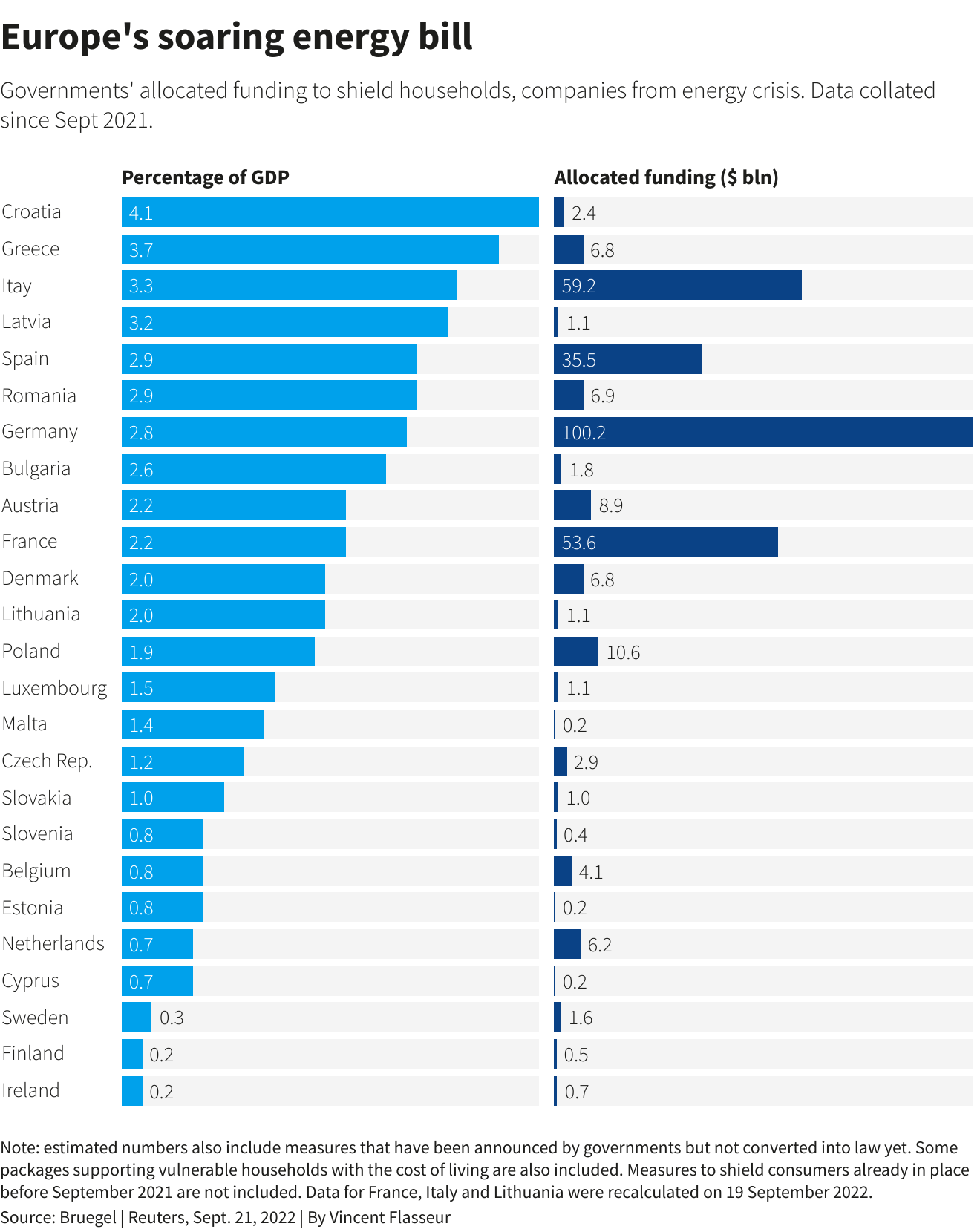Greenify #31: Nord Stream leaking!
September 30, 2022
Welcome to Greenify! Subscribe now and thank us later for not missing the most insightful information on the booming #GreenTransition!
Please help us improve by leaving a comment or feedback, and if you like what you are learning… share it with your network 😁!
📌 Fact of the week
According to the International Energy Agency (IEA), only 2 out of the 55 components of the energy system are on track to reach Net-Zero by 2050… Suggesting we need to do more!
Hottest news of the week…
Regulation 🗃 – Germany launches €200B scheme to cap prices☂️
What happened: While someone was making holes into Nord Stream 1 and 2 (read the “Comment of the week” below), Germany’s Chancellor Olaf Scholz announced a €200m umbrella to protect end-consumers from the rising cost of gas. 😮 The money will be used in various manners, although the largest bracket will be used to compensate gas importers with the difference between the amount paid to purchase the gas and a nationally agreed price cap. 💸
Zoom-out: The large debt issued raised criticisms from many parties, especially from neighbouring countries, which accuse Germany of not respecting EU boundaries on debt levels. However, according to experts, this measure sends a clear signal that European countries are economically strong and cannot be blackmailed💪. If you’d like a recap of how much countries have spent to contrast the energy crisis, check the “Graph of the week” below. 👇
Business 💰 – Solar overtakes wind also in China! ☀️
What happened: It is now official that the electircity produced by solar panels has surpassed that generated through wind turbines also in China, with solar now standing at 350 GW and wind at 345 GW per year! (To contextualize: Italy’s total electricity consumption is around 320 GW). The race does not stop here, as according to China’s leading solar association the country could install as much as 100GW overall in 2022. 😮
Zoom out: Both wind and solar are currently cheaper sources of electricity than fossil fuels, when accounting for set-up costs. In early days, wind turbines used to be much cheaper than solar panels, but with time the solar supply chain managed to reduce costs drastically, becoming the cheapest option in many areas. According to Bloomberg NEF, worldwide solar capacity overtook wind in 20219, and is expected to be twice its size by 2030.🚀
Innovation 💡 - Solar panels in the space, could we do it? 🛰
What happened: Chinese solar power company, Longi Green Energy Technology, affirmed it will be sending solar panels to orbit, as they’ll try to establish a 24/7 operation which aims at intaking solar energy and subsequently sending it back to Earth.
Zoom out: We’ve discussed previously the energy trilemma, as an energy source needs to be: 1) cheap, 2) reliable, 3) clean. One of the main issue with solar power has always been reliability, as it only works when the light shines during the day. However, if in space, theoretically solar panels could “collect” solar energy all day long. According to Bloomberg, other nations such as the U.S., Japan, Russia and India are studying possibilities in the same area.💪
Deep dives of the week…
Graph of the week - Which country is spending the most to protect bills?
This graph is a few days old and therefore does not include Germany’s €200m bazooka… but guess what? Germany was already the highest spending country before the scheme’s announcement! Looking at spending in relation to GDP, Croatia, Greece, and Italy are leading the way, although Germany has now caught up! 💵
Company of the week - Sweep for Finance is here! 🧹
In previous editions we spoke about the importance of tracking carbon emissions for companies, because if we are aware of how and where we emit, then it becomes easier to reduce our footprint! This week, our chosen company is the leading carbon accounting platform “Sweep”, which has just rolled out its “Sweep for Finance” platform, tailored at banks and other financial institutions, ultimately helping them to improve their ESG metrics! Have a look at their page if curious on how it works!
Comment of the week - Ruptures in the Nord Streams! 😱
What happened? 🤔
Earlier this week, two ruptures were found in Nord Stream 1 and one rupture in Nord Stream 2, gas pipelines in the Baltic Sea, relatively close to Danish soil. Nord Stream 1 is normally a key supplier of gas to Europe; despite supply of gas had been temporarily halted in August due to “maintenance” work, the pipeline still contained pressurized gas. The same for Nord Stream 2, although it was not operational yet.
How did it happen? 🕵️♀️
We are no experts, but according to several people who are, the ruptures were too big for this leakage to be classified as an accident. Denmark’s prime minister has told the media these ruptures are clearly Russia’s deliberate action… and he’s not alone. Other EU diplomats agree with this idea.
What does that mean? 😬
The Russia-Ukraine conflict seems to only escalate further. As we get closer to winter, when Europe’s heating demand and thus gas demand will be higher, this is an issue. We think this event should be interpreted as Russia’s intention to send a message to Europe: they are ready to shut down gas supplies completely, if necessary. Energy markets are not controlled by the laws of supply and demand anymore, but it is only a matter of geopolitics. Surely, diplomacy has a lot of work to do in the coming months!
👋 See you next Friday, for the best sum up of this coming week!
If you enjoyed this edition, help us grow by liking this post, and share it with your network!



